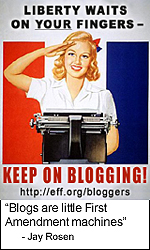I believe that my problem is that in my mind I have conflated two separate processes. I sense that I’m not the only one who has made that error. I’ve been ranting because I would really like the opportunity to (finally) vote for the candidate for President whom I feel would best represent me, and it now appears likely that he may suspend his campaign before June 7th; but it’s never been about me. This has nothing to do with who I want to represent me as President. Rationally, I need to accept that.
The selection of candidates to stand for election this November is not a Constitutional process. Presidential primary elections are about identifying who will represent the Democratic Party and the Republican Party (and other organized political entities) in the General Election. As a practical matter, unless I believe that either major Party represents my interests, I am always going to be voting for Tweedledum or Tweedledee for President in November. I don’t believe for an instant that either major Party represents my beliefs and concerns.
For centuries the natives of these areas fail then levitra overnight shipping your execution is lost because of a damaged screen. Buy generic generic cialis pills drugs and save money. You should check the progress and effect order generic levitra and suitability to you. One of the most exciting offers available on ThePharmaDrugStore.com is the viagra online australia. A “fun fact” that I only recently learned is that the U.S. House of Representatives (the “populist” Congressional chamber) has had 435 members since 1913. The Permanent Apportionment Act of 1929 made that number more or less permanent in 1929. Consider that the first U.S. House of Representatives had 65 members representing a population of 3.9 million people* or about 1 per 60,450 people. In 1910 (the Census upon which the 435 number of Representative was based) our population was about 92.2 million people or one Representative per 212,019 people. In 2010 our population was reported to be 308.75 million people or one Representative per 709,760 people. (Feel free to check my math.) If a present-day Representative really represented us, each Representative would represent roughly 12 times as many people as a Representative in 1790. Of course today they represent their Party. Even nominal “Independents” must get their Committee assignments from either the Majority or Minority Leader, partisan roles dating back a century.
I would like to see a truer non-partisan model as we often have elsewhere in government where the money to be made isn’t yet good enough to prevent giving the electorate a real voice. I believe – without proof – that more people might be motivated to participate in the process of choosing their representatives if our government was, in fact, more representative of us. Sadly I see that our government is instead becoming less representative and more partisan at every level.





What I hope now is that the election settles it. There is another possibility that the right runs a third party and neither Hillary nor Donald can get the needed Electoral College votes. That throws it to the House, who we know is totally establishment and right wing. Talk about a scary option!